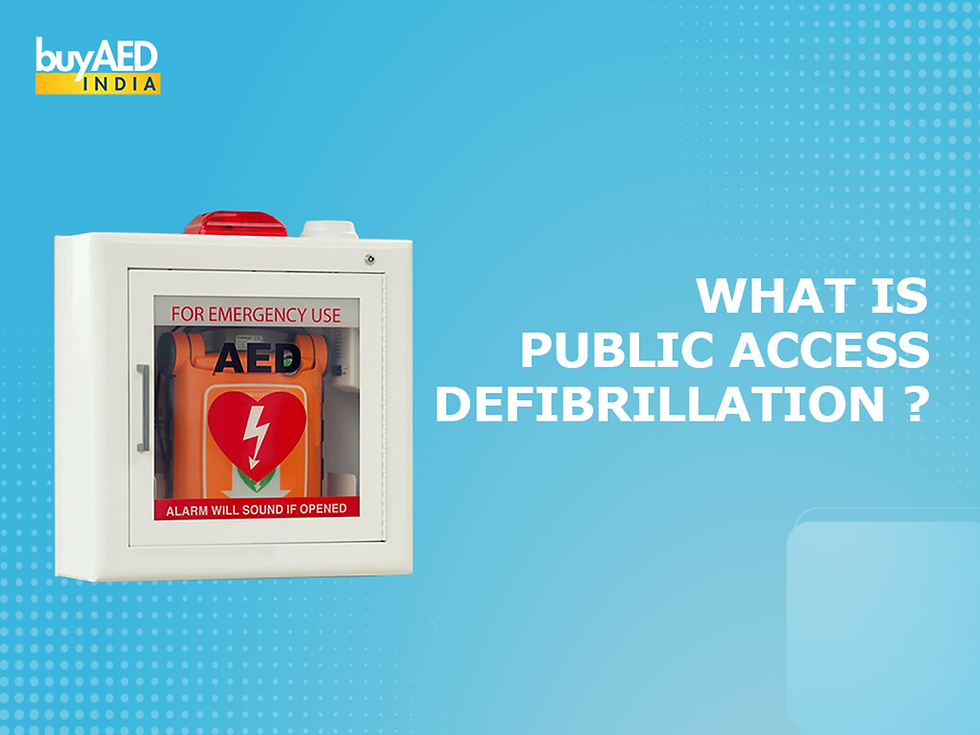How to Check if a Defibrillator is Working?
- Dr. Shruti Shah

- Aug 1
- 6 min read

During an emergency, time is crucial. Automated External Defibrillators (AEDs) are life-saving mechanisms, which ensure to normalize the heart rhythm during a sudden cardiac arrest (SCA).
However, the question that comes up is; But what happens when you do not need your AED? It is not only a minor inconvenience, but it can be life and death.
The most unfortunate part is that there are several things that most of the places in the community, offices, schools and even homes forget but one major thing is AED maintenance.
Like any other piece of technology, AEDs require routine inspection and occasional preventive care to make sure that they are in action whenever required.
Device may appear fine on the surface, but the pads may have expired, the battery may be dead, or something may have gone wrong on the inside which you cannot see.
The trend of AEDs of high quality is increasing in India and services such as Buy AED India provides a variety of reputed brands and spares.
Nonetheless, the finest AED in the market can only work when it is being taken care of well and inspected.
This blog will guide you through all you require to know on whether your AED is in proper working condition, its inspection interval as well as what to do should you have problems with it.
So now we are going to take a closer look at the full checklist of keeping your defibrillator in the best functioning guidelines.
How Often Should You Check an AED?
Regular checks are not only recommended, but they are required. AEDs are not provided by self-checking features, meaning that it does not mean that you do not need to carry out regular inspections.
A general guideline is to:
Check your AED once a month.
Use manufacturer-specific inspection schedule- some of the devices might need to be checked weekly or even daily, depending on the use-case and application location.
Upon each use, inspect visually to determine that there is nothing damaged or left undone.
It is a good practice to check your AED more regularly too in case it is stored in the common place, or it is used in regularly dust exposed, humid, or handles environment.
The most important elements to check include:
Battery (see expiration date/remaining charge indicator)
Electrode pad packing (sealed and with expiration)
General unit state (no cracks, missing components, no dust)
Indicator lights or status monitors
Regular checks will allow for avoiding any inconveniences in the case of an emergency and will ensure that you are in compliance with health and safety procedures.
What are AED Error Alerts?
New AEDs have in-built diagnostic systems. The systems perform automatic self-tests, usually on daily, weekly, or monthly periods, according to the brand.
Should anything go wrong, the majority of the devices will indicate a problem through some visual or audible error messages.
The possible meaning of some of the common AED error indicators is as follows:
Flashing Red light: It normally means that there is something wrong with the battery being low or the pads being outdated or the self-test failing.
No indicator light: In case the light is always present and now turned off fully, it may indicate an empty battery.
Beeping sounds or constant alarms: This type of assistance is applied in case the AED detects a serious fault.
On screen error messages (advanced versions): The high-tech AEDs (more expensive) will show diagnostic messages on screen so be sure to consult the manual ("decode"), they are often different and may share common codes or common symptoms.
In case any of the following is present, your AED is not ready to use until the problem is sorted out. Exchange the defective part or even take it to the technician.
Signs that Your AED is not working
Suppose you have doubts that your AED is up to date. The following are some red flags to watch out for:
Flashing or red error detectors on the unit.
No light or sound during inspection or search (self-test).
Pads are expired or are not present at all.
Dead battery or battery out of date.
Audible alarms that don’t stop or strange sounds during start-ups.
All these problems mean that the AED, at least, cannot be safe to use in the case of a cardiac emergency.
As soon as you identify any of these red flags, you have to stop the usage of the device and exchange the defective unit or address a qualified specialist.
When using lifesaving tools, one should be time conscious, and do not waste time.
When Should You Replace Your AED?
Well maintained AEDs also have an expiration date. The average life of an AED device is approximately 8 to 10 years depending on the make and usage.
Still, some of them need to be replaced more often:
Batteries tend to have a life span of 2-5 years and have to be repaired when they expire.
Electrode pads usually go bad in 18-30 months (about 2 and a half years).
You also need to think of replacing your AED device when:
It does not pass various self-checks despite battery and pads replacement.
No more parts are manufactured to replace your model.
The unit is broken, or it has experienced tough conditions in the course of its life.
Buy AED India provides genuine products of brands operating throughout the world of the latest models, spare components, or even the entire AED.
When buying through a rated dealer, it guarantees the quality of the product and after-sales services.
What Happens If You Use a Faulty AED?
Using a defective Automated External Defibrillator (AED) in case of emergency is dangerous.
Failure of a defibrillator, delivering a shock or delivering it in a timely manner, can severely decrease the probability of a person surviving sudden cardiac arrest.
Time is important when it comes down to it and having an AED that does not work wastes those precious minutes besides giving a false sense of security to the responder.
Malfunction can occur as a result of inaccurate diagnostics, expired pads, or dead batteries.
When shock transmission takes place at an inappropriate time, the heart would not be able to resume normal rhythm, and permanent brain damage is possible.
This is why a preventative maintenance practice, which involves timely replacement of used AED components, is not an option, but rather a life-saving process that should be implemented on the AEDs.
The Role of Buy AED India in the Reliable Support
When you have the idea of where to support, service, and obtain spare parts of your AED, it becomes a lot easier.
Buy AED India is a popular online supplier that specializes in different automated external defibrillators, accessories, and parts of replacement.
That is why Buy AED India is a favorite among the AED owners throughout India:
Protected brand names: Brands such as Philips, Zoll, and Cardio are all available in one place.
OEM spare components: Batteries, electrode pads, wall cabinets, and carry cases, all of them are of the original quality checked.
After-sales support: You do not only purchase a product, but you will also get professional advice, warranty and servicing support.
Fast delivery in India: Time is of the essence in the case of an emergency. Buy AED India will guarantee that you will be able to have ready AEDs because of timely deliveries.
For organizations and healthcare professionals who prioritize safety and reliability, Buy AED India is a go-to source for ensuring that your defibrillator stays in working order.
How to Maintain Your AED in the Best Condition?
Maintenance AED is not complex, and the main aspect is consistency. Some of the effective maintenance tips are as follows:
Log checks: Have a log to conduct checks whenever inspecting the AED. This will aid in monitoring performance over time.
Store appropriately: Avoid putting the AED in wet, hot environments, liquids or direct sun; store it in a cool, dry location. Use AED wall cabinets or cases that would aid in avoiding physical damage.
Educate your employees: Make sure that every person that might be required to operate the AED is aware of how to use it. Even a perfect device is useless without trained personnel.
Order spare pads and batteries early: Do not make it until a warning light appears to place your order. Prepare yourself with the necessities of reliable outlets such as Buy AED India
Follow manufacturer guidelines: There should always be a model specific instruction on how checks must be done and certain parts replaced as per recommendations of the instruction manual given by the manufacturers.
By following these tips, the AED will be in good condition and besides you will become confident in manners that your employees or family members will take appropriate measures in case of an emergency.
Conclusion
AED is one of the most efficient things you should have in the event of a cardiac emergency, yet still, to be efficient, it should operate in the moment of need.
Neglecting the maintenance reviews or delaying the replacement of some parts can make the best AED useless at the crucial moment.
This is why frequent check-ups, and awareness of any signs are needed as well as the early replacements cannot be neglected.
Through a neat maintenance schedule, being sensitive of red flags early on, and sourcing your parts or devices from quality providers like Buy AED India one can also be sure that the defibrillator is always ready when something or someone’s life depends on it.
Be it the procedure of testing the battery or having spare pads at hand, these minute things can have an enormous impact.
Never wait to receive a wakeup call. Check your AED today and in case you require replacement parts or even another unit, count on Buy AED India to be there standing by you, after all, there are not maybe when it comes to saving a life.
If you are confused about finding one that offers both quality and affordability, don’t forget to check out Philips Defibrillators from Buy AED India, which will meet your needs.





Comments